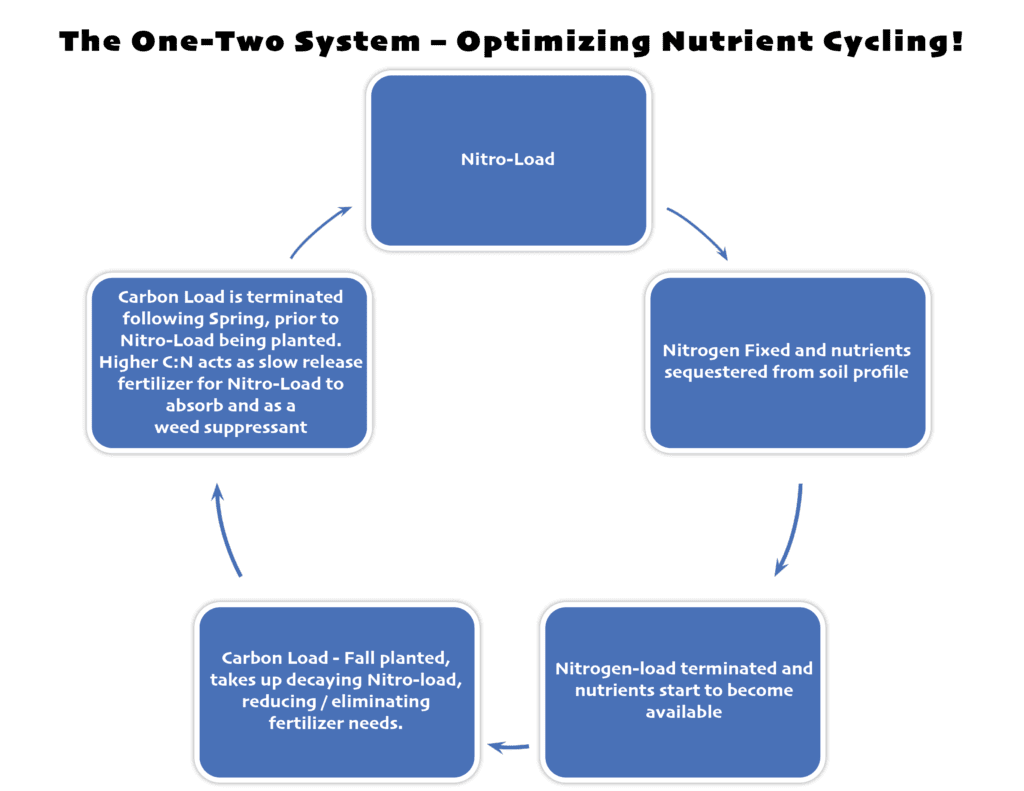At Vitalize Seed, we often preach about nutrient cycling. As we go down this rabbit hole, it is very easy for folks to assume that if N fixing is a good thing; more must be better! This is where we can get into trouble.
Nitrogen fixation occurs through legumes and the bacteria (rhizobacteria) in the soil that colonize roots and fixes atmospheric N. Note: there has been science that shows it can also occur in highly functioning microbial systems, with the increase in microbe populations and the response to diverse plant species within the microbiome, outside of solely legumes. I digress. The importance behind nitrogen fixation is often discussed and, one could argue, often over-simplified.
The part that is left out is the rest of the nitrogen cycle. Nitrogen will naturally cycle from gas (N2) or NH4 (ammonium – often from decomposition/nitrification) and will eventually be making its way to nitrate (N03). Again, there is a science that shows plants can assimilate both ammonium and nitrate but for this article, let’s just assume nitrate assimilation is the main topic.
Nitrate is the most leachable form of nitrogen and, depending on your growers’ practices and soil structure, you can easily lose some of the nitrogen your plants and ecosystem worked so hard to convert! This is one of the reasons why a monoculture of legumes is not a benefit to the system as a whole. Nitrate leachability is a major issue, from environmental pollution to pulling Ca off the soil colloid, which can further change our soil structure.
This brings us to the importance of nitrogen mining. Nitrogen mining can occur through various crops that “like” nitrogen. For simplicity, let’s look at radish. Radish has been shown to scavenge a lot of nitrates from the soil profile and convert this nitrate into organic forms that can then be released and re-used during the next planting cycle as the radish decomposes. I have read about ranges from 70 to 200 lbs per acre of N scavenging!
Some research papers refer to this as nitrate recycling, which I think is great! It helps to visualize the importance of having diverse crops in our system that assimilate various nutrients, convert them, and again make them available for subsequent plantings. This is the idea behind nutrient cycling (specifically N but we can cover others in another write-up)!
We can reduce our dependence on synthetics as we increase our input of nitrogen through N fixation. This is all occurring via the microbes and recycling any additional nitrogen through scavenging and recycling!
So now that we have a general understanding of the nitrogen cycle, this allows us to have a better understanding of why balanced carbon to nitrogen mixes are so important! If we have too much N in the system, our microbes will look for carbon and can literally “mine” our organic matter out of our systems if we don’t have another adequate carbon source. If we have too much carbon in the system and not enough N, we can have N tie-up, which results in major grower frustration and can often lead to turning the soil or spraying N to help expedite the thatch breakdown.
With the Vitalize Seed Mixes, we can continue to fix N and cycle it through our balanced system. We are further able to sequester other nutrients in the soil profile through the feeding of microbes and fungi which results in more complex nutrient cycling.
As we plant our spring and summer mixes, we prepare our soil for fall and our fall mix prepares our soil for spring! Each subsequent year, the planting becomes more and more efficient as our nutrient cycling is enhanced through stronger microbial and fungal populations.
